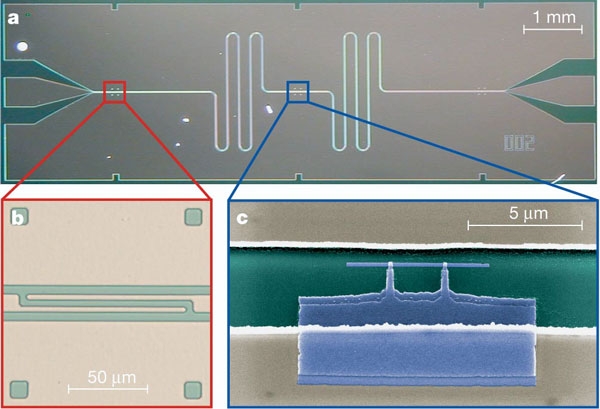Researchers in many fields of physics have envisaged coupling a single quantum two-level system coherently to a quantum harmonic oscillator, see R. J. Schoelkopf & S. M. Girvin, Nature 451, 664-669 (2008)and references therein. Until 2004 this feat had only been achieved in the realm of atomic physics and quantum optics, where a single atom was observed to coherently exchange a single photon with a single mode radiation field in atomic cavity QED experiments. Such experiments have contributed greatly to our fundamental understanding of the interaction of matter and light, of the physics of open quantum systems and of coherence and decoherence. They are also a major test ground for demonstrating the general concepts of quantum information processing.
 |
|
Fig. 1: Microscopic images of a superconducting cooper pair box qubit coupled to a transmission line resonator. Image: A. Wallraff et al., Nature 431, 162-167 (2004) (large view) |
In an experimental breakthrough at Yale in 2004, Andreas Wallraff and collaborators have demonstrated for the first time that a solid-state nano-electronic quantum circuit can be coupled coherently to a single microwave photon [1]. The success of this approach is based on our ability to design and fabricate mesoscopic solid-state two-level systems with large effective electric dipole moments (d ~ 104 e a0) and 1D on-chip cavities with very large vacuum electric fields (E0 > 0.1 V/m) leading to large controllable electric dipole interactions. Mastering a number of experimental challenges, we have realized the new paradigm of circuit quantum electrodynamics (or in short cirquit QED) which has developed into an active research field in its own right. In circuit QED coherent quantum optical effects are observed even in a solid state environment where coupling to environmental degrees of freedom leading to decoherence is typically much larger than in atomic systems.
The circuit QED system is extremely attractive for performing fundamental cavity QED experiments. Its properties can be designed at will and tuned in situ in experiment. As a result circuit QED has already enabled experiments that go beyond the current state of the art of atomic cavity QED. Selected examples of our work in this area include the measurement of the Lamb shift [2] in a circuit and the observation of the quantum nonlinearity of the interaction of a single qubit with a small number of photons [3].
References:
[1] Strong coupling of a single photon to a superconducting qubit using circuit quantum electrodynamics, Nature 431, 162-167 (2004), also in [arXiv:0407325 | Nature News & Views]
[2] Resolving Vacuum Fluctuations in an Electrical Circuit by Measuring the Lamb Shift, Science 322, 1357-1360 (2008) [Nature News & Views]
[3] Climbing the Jaynes-Cummings ladder and observing its nonlinearity in a cavity QED system, Nature 454, 315–318 (2008)


